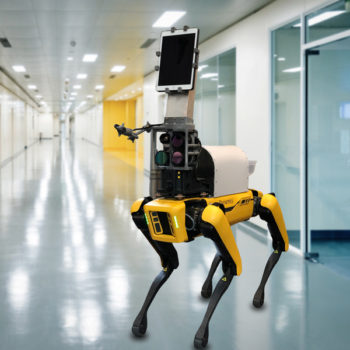

Since the start of the pandemic, we’ve seen countless photos of overworked nurses covered in PPE swabbing the mouths of patients at drive-thru testing centers all over the country, but this method of testing people for COVID-19 and other infectious disease may soon go the way of the dinosaur.
Scientists are looking for alternative ways to monitor a patient’s vital signs, so the provider doesn’t have to get as close to the patient. This will reduce the need for PPE, limit the rate of infection among healthcare workers, and increase efficiency in hospital and patient care settings.
The healthcare industry has been experimenting with AI and automation for years, but a new dog-like robot known as “Spot” is gaining a lot of attention for its potential ability to monitor patients from a distance. Nearly six-feet tall, it walks on four mechanical legs as it examines the person’s vital signs. Learn what makes Spot so appealing to frontline workers and the medical community.
Reducing the Risks
Researchers from MIT and Brigham and Women’s Hospital don’t want to see any more front line workers fall prey to COVID-19. One of the painful realities of the pandemic is that nurses and first-responders need to get close to patients to diagnose their conditions. This increases their risk to exposure at a time when everyone should be practicing social distancing.
That’s why Spot is considered such a revelation. It uses four built-in cameras, including one infrared camera and three monochrome cameras, that filter different wavelengths of light to measure skin temperature, breathing rate, pulse rate, and blood oxygen saturation in patients from a distance of two meters.
The creators of Spot see this as a potential alternative to drive-thru testing centers and the makeshift triage tents that have been all over the U.S. in recent months. Providers can control Spot using a handheld device as they move the robot from room to room. In theory, this would allow them to quickly evaluate patients without increasing their chances of infection.
High body temperature is one of the biggest symptoms of COVID-19. Instead of inserting a thermometer into the patient’s mouth or using a temperature gun, which can be faulty, Spot uses an infrared camera to measure the body temperature of the face. An algorithm then correlates that temperature with core body temperature for an accurate reading of the patient’s vitals. It also accounts for ambient temperature, the distance between the patient and provider, and other external factors that may affect the final diagnosis, including the weather and changes in the camera angle.
The infrared camera can also use this information to determine the individual’s breathing rate. As a person breathes, the air from their mouth changes the temperature of the mask. Measuring this temperature change allows the researchers to calculate how rapidly the patient is breathing. The monochrome cameras can also detect how much oxygen is in the patient’s blood based on color. When hemoglobin binds to oxygen in blood cells, it changes the color of the air.
Tackling COVID-19
Researchers say they have been designing Spot specifically for COVID-19. It uses these features to quickly assess symptoms associated with the deadly virus. However, it has yet to be used in hospital settings. So far, scientists have only tried the robot on healthy volunteers, but they are working on deploying Spot in a hospital emergency department in the near future, so it can screen incoming patients for signs of COVID-19.
They believe it has the potential to revolutionize patient care by continuously monitoring patient vitals without spreading existing providers too thin. The team posted the report on their system on the preprint server techRxiv and have submitted the full study for peer-review. If Spot is going to be used in patient care settings, it will need to be approved by the Food and Drug Administration.
The invention of Spot makes it clear that we have the technology to remotely monitor a patient’s vital signs. In the aftermath of COVID-19, we may see more hospitals installing infrared and monochrome cameras as a way of tracking blood oxygen levels, pulse rate, and core body temperature. Hopefully, we would then never have to use those pop-up tents ever again.
When we discuss students, we always mention their qualities. Those qualities show what they are…
If you or someone you know is juggling mental health issues alongside substance abuse, understanding…
For the last couple of weeks, the Israel-Hamas conflict has taken over the news cycle.…
Our eyes are invaluable, serving as our windows to the world. The ability to see…
Undoubtedly, one of the most demanding and challenging professions is nursing. Nurses work long hours in…
Echocardiography, or echo for short, is a key diagnostic test used by cardiologists to assess…